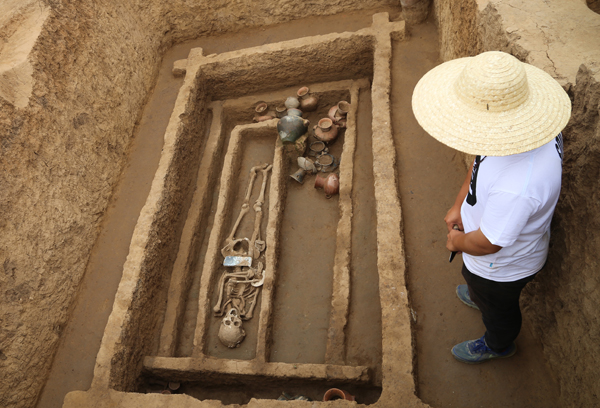Tag Archives: China
Firefighters called on to rescue ‘lady of the rings’
|
|
|
The seven rings that needed to be cut free by firefighters. [Photo/Shanghai Daily] |
A woman in her 70s who wears nine rings found she couldn’t remove them from her fingers and firefighters were needed to end the pain she was suffering.
One of the rings had cut into the flesh, Huangpu District’s fire department said yesterday.
Last Friday, two fire brigades received reports from Shanghai General Hospital that the woman was in pain. The hospital had already managed to take off two of the rings, but couldn’t remove the other seven.
Like many elderly people, the woman whose name wasn’t disclosed, had worn ill-fitting rings for a long time, causing her fingers to become swollen. She ignored the problem until one of the rings tore into her finger, bringing with it “unbearable pain.”
To avoid hurting her, the firefighters first removed the easiest-to-get-at rings, and then used a special set of tools to take off another three.
Removing the six rings took firefighters two hours.
But that still left one ring — the one that had bitten into the flesh.
The firefighters worked with doctors to finally finish the job.
The “lady of rings,” as her helpers called her, is said to have called on Hongkou’s fire brigade to help to remove rings on three other occasions, but every time she had later put the rings back on.
read moreArcheologists find 5,000-year-old giants
|
|
|
The archaeological site in Jinan, Shandong Province, where the skeleton of an unusually tall man was found. [Photo/China Daily] |
Archeologists have found some people in East China 5,000 years ago to be unusually tall and strong.
Measurements of bones from graves in Shandong Province show the height of at least one man to have reached 1.9 meters with quite a few at 1.8 meters or taller.
“This is just based on the bone structure. If he was a living person, his height would certainly exceed 1.9 meters,” said Fang Hui, head of Shandong University’s school of history and culture.
From 2016, archeologists have been excavating the ruins of 104 houses, 205 graves and 20 sacrificial pits at Jiaojia village in Zhangqiu district, Jinan city, capital of Shandong.
The relics are from the Longshan Culture, a late Neolithic civilization in the middle and lower reaches of the Yellow River, named after Mount Longshan in Zhangqiu.
“Already agricultural at that time, people had diverse and rich food resources and thus their physique changed, “said Fang.
Millet was the major crop and people raised pigs, according to Fang. Pig bones and teeth were found in some graves.
According to the findings, taller men were found in larger tombs, possibly because such people had a high status and were able to acquire better food.
Shandong locals believe height to be one of their defining characteristics. Confucius (551-479 BC), a native of the region, was said to be about 1.9 meters tall.
Official statistics back up the claim. In 2015, the average height of men aged 18 in Shandong was 1.753 meters, compared with a national average of 1.72 meters.
Ruins of rows of houses in the area indicate that people lived quite comfortable lives, with separate bedrooms and kitchens, according to the excavations.
Colorful pottery and jade articles have also been found, said Wang Fen, head of the Jiaojia excavation team.
The area was believed to the political, economic and cultural center of northern Shandong 5,000 years ago. Ruins of ditches and clay embankments were also found.
The Jiaojia ruins fill a cultural blank 4,500 to 5,000 years ago in the lower reaches of the Yellow River, said Wang Yongbo of the Shandong Provincial Institute of Archeology.
Archaeologists found obvious damage to the head and leg bones of some of the bodies and to pottery and jade articles in six large tombs. The damage may have been done not long after the burials and may be due to power struggles among high-ranking people.
Li Boqian, an archaeologist with Peking University, said the excavations showed Jiaojia in a transition phase, but proved the existence of ancient states 5,000 years ago in the basin of lower Yellow River.
The range of the Jiaojia site has been enlarged from an initial 240,000 square meters to 1 sq km. Currently, only 2,000 square meters has been excavated.
“Further study and excavation of the site is of great value to our understanding of the origin of culture in east China,” said Zhou Xiaobo, deputy head of Shandong provincial bureau of cultural heritage.
read more47 dead, 22 missing after flood hits Hunan, Guangxi
A total of 47 people died and 22 are missing as floods wreaked havoc in central China’s Hunan Province and Guangxi Zhuang Autonomous Region in the south. In Hunan, heavy rain starting on June 22 has killed 27 people with 8 missing. The ensuing floods … read more
Gas pipeline explosion kills 5, injures 89 in N. China
A fire truck joins the rescue after the explosion in Songyuan city, Northeast China’s Jilin Province, July 5, 2017. [Photo/Sina Weibo] Gas pipeline explosion that happened Tuesday has left at least five people dead and 89 others injured in Songyu… read more



 0
0 








